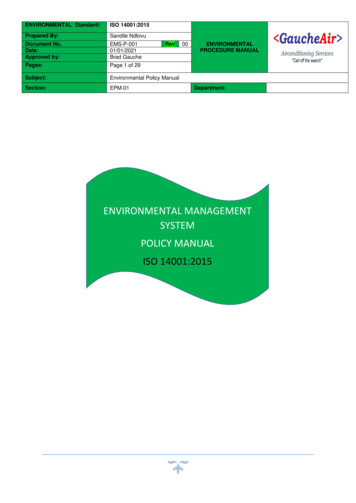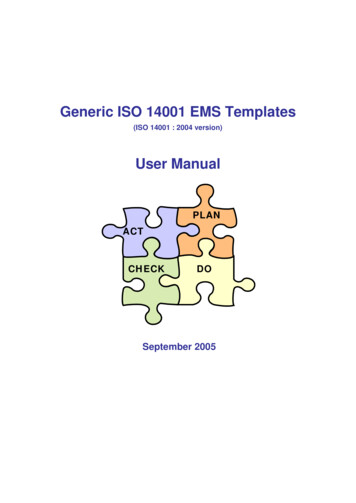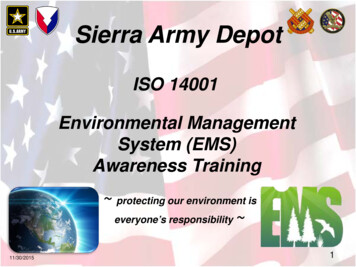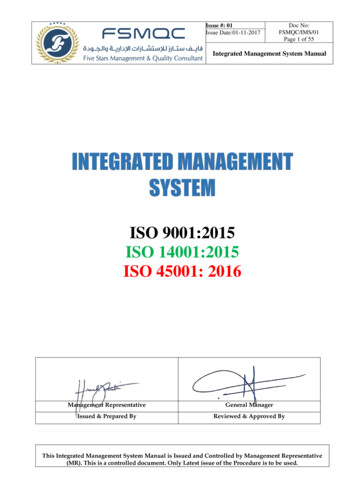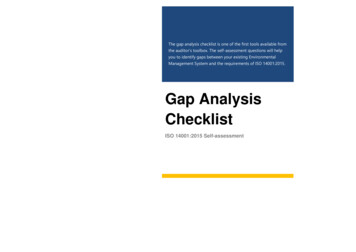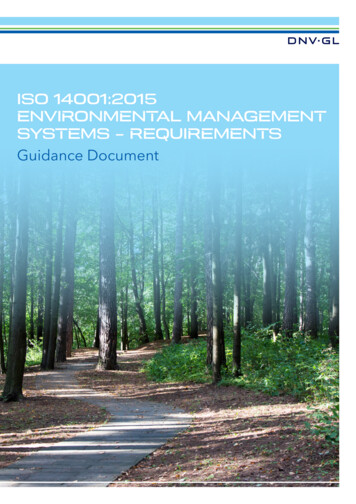
Transcription
ISO 14001:2015ENVIRONMENTAL MANAGEMENTSYSTEMS – REQUIREMENTSGuidance Document
IntroductionHow we can helpThis DNV GL guidance document aims to give a basic overviewof the changes to ISO 14001, resulting from the review andrevision of the 2004 standard. It is not intended to give anexhaustive and in-depth explanation of all requirements in thenew standard.We are here to support you during the transition, through;ISO standards are reviewed and revised on a regular cycle, typicallyevery 5-10 years, and 2015 sees ISO 14001:2004 reaching theend of that review process. A draft international standard (DIS) waspublished, and after extensive review the final draft internationalstandard (FDIS) was published in July. The ISO 14001:2015standard was published in September 2015. direct contact, e.g. with your lead auditor as part ofscheduled audits open webinars and transition training classroom transition training courses, tailored to your needs gap analysis, either as a separate activity or combined withscheduled audit activity combination of training and gap analysis “Questions on the ISO 9001:2015 and ISO 14001:2015revisions” – LinkedIn discussion groupThe ISO organization has developed a common Higher LevelStructure (HLS) for management system standards, issued underan ISO ctives.htmlThat directive has a series of annexes, of which we are interestedin “Annex SL – Proposals for management systems standards”.This annex states that all management system standards will usea consistent structure, common text and terminology, and thisis enacted through “Appendix 2 – High level structure, identicalcore text, common terms and core definitions”.Some revised and new standards have already implementedthis requirement – for example ISO 27001:2013 InformationSecurity Management Systems (revised) and ISO 55001:2014Asset Management Standard (new).ISO 14001 has therefore been revised in accordance with thenew HLS, but it also contains additional content.A whole range of country-level committees feed into the overallISO committees which meet to decide on the revisions. Thecommittee for ISO 14001 is TC 207. If you are a member ofIEMA, or a trade federation, you can access the latest version(s)of the draft Standard(s) and even comment on the content.After the new standards are published, there will be a transitionperiod for fully complying with them. This period will be 3 years,but it is strongly recommended that you start thinking nowabout how it will impact you, and review what changes mightbe needed.Page 1DNV GL AS, NO-1322 Høvik, Norway, Tel: 47 67 57 99 00, www.dnvgl.comVersion 12.08.15
Layout of ISO 14001:20151Scope2Normative References3Terms and definitions4Context of the organization4.1Understanding the organization and its context4.2 Understanding the needs and expectations of interested parties4.3 Determining the scope of the quality management system4.4Environmental management system55.15.25.3LeadershipLeadership and commitmentEnvironmental policyOrganizational roles, responsibilities and authorities66.16.2PlanningActions to address risks and opportunitiesEnvironmental objectives and planning to achieve enessCommunicationDocumented information88.18.2OperationOperational planning and controlEmergency preparedness and response99.19.29.3Performance evaluationMonitoring, measurement, analysis and evaluationInternal auditManagement y and corrective actionContinual improvementPage 2DNV GL AS, NO-1322 Høvik, Norway, Tel: 47 67 57 99 00, www.dnvgl.comVersion 12.08.15
1. Scope4.1 Understanding the organizationand its contextThis section explains the scope of the standard – i.e. what it isfor and what it encompasses. It introduces the requirementsof an environmental management system which supports thefundamental ‘environmental pillar’ of sustainability, together withthe key intended outcomes of a management system including:This clause requires the organization to consider a wide nnnenhancement of performance;conforming to compliance obligations;fulfilment of objectivesThis section also makes clear that any organization claimingcompliance with the revised standard should have incorporatedall requirements of the standard within their environmentalmanagement system.2. Normative referencesAs with ISO 14001:2004 there are no normative referencesassociated with ISO 14001:2015. The clause is included simplyin order to maintain consistent alignment with the ISO HighLevel Structure (HLS).3. Terms and definitionsThis clause lists the terms and definitions that apply to thestandard – these are referenced where necessary back toother ISO 14001 standards (e.g. ISO 14031:2013). TheISO 14001:2015 standard extends the list of terms anddefinitions from the ISO 14001:2004 standard, combining themandated HLS terms and definitions together with the morespecific terms and definitions associated with environmentalmanagement systems.4. Context of theorganizationThis clause sets out the requirements for an organization totake a high level overview of the business, considering the keyinternal and external factors which impact it, and how it shouldrespond in the form of a defined management system.range of potential factors which can impact on themanagement system, in terms of its structure, scope,implementation and operation. The areas for consideration quoted in the Annex Aguidance of the standard are wide-ranging, including; a) environmental conditions related to climate, air quality,water quality, land use, existing contamination, naturalresource availability and biodiversity, that can eitheraffect the organization’s purpose, or be affected by itsenvironmental aspects; b) the external cultural, social, political, legal, regulatory,financial, technological, economic, natural andcompetitive circumstances, whether international,national, regional or local; c) the internal characteristics or conditions of theorganization, such as its activities, products and services,strategic direction, culture and capabilities (i.e. people,knowledge, processes, systems).4.2 Understanding the needs andexpectations of interested partiesClause 4.2 requires the organization to determine the need and expectations of “interested parties”, bothinternal and external. Previous versions of the draftstandard also contained the term “stakeholder”, whichmany organizations will be more familiar with – the termsare synonymous and there is no need to consider them tobe any different. Interested parties could overnmental Organizations (NGOs)Parent organizations What is clear is that whilst the consideration of contextand interested parties needs to be relevant to thescope and the standard, the assessment needs to beappropriate and proportionate.Page 3DNV GL AS, NO-1322 Høvik, Norway, Tel: 47 67 57 99 00, www.dnvgl.comVersion 12.08.15
What is also clear is that the output from clauses 4.1 and4.2 is a key input to the assessment and determinationof risks and opportunities required in clause 6. There arevarious methods and approaches which can be used tocapture these inputs. As with any significant revision tostandards, hopefully there will be the development of arange of methods and examples for this. Some currentexamples include;Internal and External Issuesn Key economic and market development which canimpact an organization. Your organization is probablyacutely aware of what is happening in its markets butthis may be undertaken in a very ad-hoc way,n Technological innovations and developments isalso an area critical to your business success andis also probably being monitored and discussed atnumerous levels,n Regulatory developments - there is a whole rangeof external regulations being monitored by yourorganization; if you miss them then it could seriouslydamage your business, or if you capture early intelligenceon them you can more effectively manage any risks,n Political and other instabilities - if for example yourely on raw materials from one particular countrywhich experiences major instability, your wholebusiness could be jeopardized; or if there aremajor environmental concerns regarding a sourceof materials or goods this could have significantreputational consequences,n Organizational culture and attitudes - an effective andmotivated workforce will give you positive impacts, andmany organizations canvas feedback from employees.Internal and External Partiesn Stakeholder engagement exercises are alreadywidely used to consult with interested parties andmap out concerns and issues. More often used bylarger organizations engaging with corporate socialresponsibility initiatives,n Consultation meetings with neighbourhoods andNGOs on environment, planning and developmentissues are often used by major industrial plants withsignificant HSE risks,n Meetings and other interactions with regulators canencompass, for example, critical issues on productspecifications and conformity from an environmentalperspective, as well as issues with regulators oncompliance and developing compliance againstemerging requirements and standards,Page 4n Employee meetings, consultations and feedbackactivities - this should be happening already, butmaybe this will prompt more efforts to improve anarea which has been at risk of “lip service” to ISO14001:2004,n Supplier reviews and relationship management- manyorganizations are trying to get much more mutualbenefit from the supplier-client relationships which arecritical to mutual success.n Client/customer reviews and relationship management- of course this is a fundamental pillar of all standardsand a key to success. It may be that when you reflect on how you capture keyissues, and how many interested parties you engage withalready, you may be pleasantly surprised. It may be thatyou only engage with a limited number of internal andexternal parties, but now is the time to start thinking aboutwhether that is enough, and whether you are missingsome good opportunities. There will be many ways in which to capture this – andhopefully some improved and new approaches mightemerge as this part of the standard is considered.Approaches could include;n Summary information from the range of existingapproaches used as listed above (e.g. a brief report),n Information summarised as part of inputs to risk andopportunity registers (e.g. for ISO 14001 this couldbe an additional process in the identification ofenvironmental aspects and impacts),n Recorded in a simple spreadsheet,n Logged and maintained in a database,n Captured and recorded through key meetings. These clauses are asking organizations to think clearlyand logically about what can internally and externallyaffect their management systems, and to be in a positionto show that this information is being monitored andreviewed. It also requires organizations to elevate thediscussions to the highest levels, since capturing theabove range of information is hard to achieve without ahigh level approach.DNV GL AS, NO-1322 Høvik, Norway, Tel: 47 67 57 99 00, www.dnvgl.comVersion 12.08.15
4.3 Determining the scope of theenvironmental management system This clause should be familiar to most organizations,since ISO 14001:2004 clause 4.1 clearly requires thedefinition of the scope of the management system. ForISO 14001:2015 the scoping requirements have becomeclearer, stronger and require the organization to considerthe inputs from 4.1 and 4.2, along with the products andservices being delivered. This should encourage a clearer and more logicalapproach to scoping, driven by external and internalrequirements - it should not be used to excludeactivities, processes or locations which have significantenvironmental aspects and impacts and should not beused to avoid areas with clear compliance obligations.The Annex A guidance uses the term ‘credibility’ inrelation to the setting of the scope of an organization’senvironmental management systems. The scope shouldbe clearly documented and made publicly available. These clearer requirements on scoping will drive clarity inthe thinking of organizations in scoping the managementsystem. Certification bodies will, as before, look at howan organization has defined its scope, ensuring thatthis is both appropriate and is reflected accurately bythe management system and also in the scope of anycertificate issued.4.4 Environmental management system This clause basically states that the organization needs toestablish, implement, maintain and continually improvea management system in order to achieve its intendedoutcomes, including enhancement of environmentalperformance. This should also be familiar to organizationswhich implement management systems in order todeliver compliance and improvement. This clause is also more focused in requiring organizationsto understand more about the range of processesrelevant to the scope of the management system. Theterm process is defined as; “a set of interrelated orinteracting activities which transforms inputs into outputs”. For those who are committed to a management systemwhich is at the core of your business then this willprobably be an integral part of your management system.You may however need to review how effectively youconnect those processes and understand the influenceand impact of those processes on each other and on thebusiness. This should also elevate the system in termsof its importance and value to the business, because itshould drive more meaningful analysis of the key businessprocesses and critical aspects of those processes. Inpractical terms it will require an organization to morefully analyse its processes and ensure that there is goodunderstanding of how they interact with each other - andnot operate as isolated procedures without overlap. Clause 4 introduces some significant innovations tothe management system world, and could represent achallenge to some organizations who have not viewed themanagement system as essential to the business, focusedas it is on raising management systems to a higher leveland to be more central to the way an organization works –an approach which is entirely correct and logical.Page 5DNV GL AS, NO-1322 Høvik, Norway, Tel: 47 67 57 99 00, www.dnvgl.comVersion 12.08.15
5. LeadershipThis clause includes a good proportion of content which willbe familiar from ISO 14001:2004 but also introduces somesignificant changes on overall leadership and commitment andthe expectations for top management to engage more fully withthe critical aspects of the quality management system.5.1 Leadership and commitment his clause encompasses a range of key activitiesTwhich top management need in order to “demonstrateleadership and commitment with respect to themanagement system”. Therein lies one of the innovations delivered by thecommon HLS – top management must show leadershipof the management system rather than just demonstratecommitment to it. The standard is driving the oversightof the management system to the highest level ofmanagement and making it a key component of theorganization and its core business processes and activities. It doesn’t mean that the leadership has to be able toregurgitate the policy or recite the objectives and targets –what it means is that an internal or external interested partyshould feel entitled to have a discussion with leadershipabout core and critical aspects of the business, becausethese are at the heart of the management system. This sub-clause is a significant innovation to the structureof management systems, but should be viewed as a‘positive challenge’ to organizations and an opportunityto enhance the role of the environmental managementsystem and place it at the centre of the business.5.2 Environmental policy he Environmental Policy is an important documentTbecause it acts as the driver for the organization. Itprovides the direction and formally establishes goals andcommitment. Top management should ensure that the policy isappropriate, compatible with the strategic direction andnot a bland statement that could apply to any business.It should provide clear direction to allow meaningfulobjectives to be set that align with it.Page 6 The new standard focuses on commitment to ”protectionof the environment” rather than solely addressing“prevention of pollution” in the 2004-edition. Thisindicates a broader environmental view and more inline with current and future environmental challenges.Commitments to protect the environment can, in additionto prevention of pollution, also include climate changemitigation and adaptation, sustainable resource use andprotection of biodiversity and ecosystems. The policy needs to be communicated to all employeesand they need to understand the part they have in itsdeployment. The policy must be documented andavailable externally.5.3 Organizational roles, responsibilitiesand authorities or a system to function effectively, those involved needFto be fully aware of what their role is. Top managementmust ensure that key responsibilities and authorities areclearly defined and that everybody involved understandstheir roles. Defining roles is a function of planning, ensuring awarenesscan then be achieved through communication and training.It is common for organizations to use job descriptions orprocedures to define responsibilities and authorities. In ISO 14001:2015 top management are more directlyidentified as being responsible for ensuring thatthese aspects of the system are properly assigned,communicated and understood. The specific role of a Management Representative hasbeen removed – the standard still contains all of the keyactivities and responsibilities of that previously identifiedrole, but these now lie more directly within the corestructure of the organization - including top management.This has a positive implication for the environmentalmanagement system- there is a clear expectation forconsistent and appropriate ownership from top-tobottom within an organization. Clause 5 contains much familiar content, but with greateremphasis on leadership and commitment, and theexpectation that top management will be more activelyengaged with the management system.DNV GL AS, NO-1322 Høvik, Norway, Tel: 47 67 57 99 00, www.dnvgl.comVersion 12.08.15
6. PlanningThis clause is an excellent addition to ISO 14001:2015,introducing the concept of risk (and opportunity) via the HLS.DNV GL has been in the “risk” business for a very long time – inthe field of certification also, since we have been deliveringRisk Based Certification since 2004. The approach is based onthe audit being built around areas of risk to the organization’sbusiness, and auditing in depth to assess whether theorganization is managing that risk effectively.6.1 Actions to address risks and opportunities In basic terms, this clause requires the organization to;n Consider in planning the EMS the context of theorganization and the scope of the system 6.1.1;n Determine risk and opportunities relating toenvironmental aspects 6.1.2, compliance obligations6.1.3 and other issues and requirements identified in 4.1and 4.2. (6.1.1);n Also consider potential emergency situations whichcould arise and constitute risk (6.1.1)n In addition, and as required already by ISO 14001:2004,determine the range of environmental aspects andimpacts and determine those impacts which are ofsignificance to the organization within the defined scope(6.1.2);n Consider all compliance obligations applicable to theorganization and how these may present threats oropportunities (6.1.3);n The organization then needs to consider appropriateactions to address the significant aspects/impacts(6.1.2), compliance obligations (6.1.3) and risks andopportunities identified (6.1.1). The ISO 14001 standard also introduces the concept of“considering a life cycle perspective” for its products,services and activities. This makes the previous conceptsof the upstream and downstream aspects clearer, and alsointroduces language now in common use across otherstandards as well as Corporate Social Responsibility (CSR)and product assessment standards. A well-established approach to managing this range ofinputs, risk analysis and prioritisation already implementedby many organizations is the use of risk registers, whichif properly managed and implemented can effectivelyidentify and assess risks and opportunities across awide range of areas and issues. There will also be otherapproaches which result from the various relevant clausesof 14001 (e.g. the results from clause 4.1 and 4.2 and therequirements of 6.1.1, 6.1.2, 6.1.3 and 6.1.4) along withmanagement of change, with an overall analysis and reviewresulting in objectives, targets and plans. The depth and complexity of approach will dependsignificantly on the size and complexity of the organization,as well as other factors which could include level ofexternal regulation, existing requirements for publicreporting, shareholder interests, public profile, numbersand types of customers, range and types of suppliers. Hence there will be a range of approaches that will beappropriate for the wide spectrum of organizations.6.2 Environmental objectives andplanning to achieve them his clause requires the organization to establishTenvironmental objectives and plans, ensuring thatthese are clear, measurable, monitored, communicated,updated and resourced. As part of the planning process, top managementneeds to set environmental objectives driven by theoutputs from the analysis of risks arising from threats andopportunities (i.e. the range of activities undertaken in6.1), with the aim of delivering compliance, performanceimprovement and effective risk management. Objectivesshould be consistent with the Environmental Policy andbe capable of being measured. Documented information needs to kept in relation toobjectives and there will need to be evidence regardingmonitoring of achievement. The overall strength of this clause lies in both introducingthe principles of risk and opportunity to managementsystems standards via the HLS, and by connecting it veryclearly to the processes defined under Clause 4.Page 7DNV GL AS, NO-1322 Høvik, Norway, Tel: 47 67 57 99 00, www.dnvgl.comVersion 12.08.15
7. SupportAn effective environmental management system cannot bemaintained or improved without adequate resources. As afunction of planning, such resources should be determined andprovided. This clause gathers together in one place all the areasrelating to the “people, place and procedural” aspects of themanagement systems. The basic HLS clauses cover the following;n 7.1 Resourcesn 7.2 Competencen 7.3 Awarenessn 7.4 Communicationn 7.5 Documented Information7.1 Resources The main intention behind this general requirement isthat the organization must determine and provide theresources needed for the establishment, implementation,maintenance and continual improvement of theenvironmental management- covering all aspects ofpeople and infrastructure. Whilst not contained in the ISO 14001 standard, the ISO9001 standards contains a very interesting additionalrequirement termed “organizational knowledge”, whichrelates to ensuring that the organization understandsinternal and external knowledge needs and candemonstrate how this is managed. This could also includeknowledge management of resources, and ensuring thatthere is effective succession planning for personnel, andprocesses for capturing individual and group knowledge.It isn’t a documented requirement of ISO 14001 but it isrelevant and useful as a general principle.7.2 Competence In order to determine competence, competence criterianeeds to be established for each function and rolerelevant to the environmental management system. Thiscan then be used to assess existing competence anddetermine future needs. Where criteria are not met, someaction is required to fill the gap.Page 8 Training or reassignment may even be necessary.Retained documented information is required to beable to demonstrate competence. Recruitment andinduction programmes, training plans, skills tests and staffappraisals often provide evidence of competence andtheir assessment. Competency requirements are oftenincluded in recruitment notices and job descriptions. The standard is clear that documented information isrequired as evidence of competence.7.3 Awareness Personnel need to be made aware of the environmentalpolicy, significant aspects and impacts of relevance totheir activities, how they contribute to the environmentalobjectives, environmental performance and complianceobligations, and the implications of failures in compliance.7.4 Communication Effective communication is essential for a managementsystem. Top management need to ensure that mechanismsare in place to facilitate this. It should be recognised thatcommunication is two-way and will not only need to coverwhat is required, but also what was achieved. With ISO 14001:2015 the importance of internalcommunications and external communications areemphasized. This is a natural legacy of the existing ISO14001:2004 and the importance of interested parties inenvironment issues. This sub clause also makes very clear the importanceof ensuring in relation to environmental reporting andassociated communications that the organization shall“ensure that environmental information communicatedis consistent with information generated within theenvironmental management system, and is reliable”. This is an excellent addition and consistent with othercorporate reporting standards. It also emphasizes the needto plan and implement a process for communicationsalong the familiar ‘who, what, when how’ principles.DNV GL AS, NO-1322 Høvik, Norway, Tel: 47 67 57 99 00, www.dnvgl.comVersion 12.08.15
7.5 Documented informationMost of the ISO 14001:2015 text will be familiar, being similar to the requirements of ISO 14001:2004, but thereis some logical broadening to encompass electronic andweb- based media. It is worth emphasising here that thestandard no longer specifies the need for documentedprocedures – it is up to the organization to decide whatis needed. However, it does specify on a number ofoccasions the need to maintain or retain documentedinformation, in order to give structure, clarity andevidence of the system being maintained and effective.The term “documented information” now replaces thepreviously used terms “documented procedure” and“records”. In most areas this clause will not require significantchanges, but there are some of the additionalrequirements which will require some updated thinking.The changes introduced with the HLS in terms of notspecifically requiring documented procedures is inreality not a significant issue – organizations still need tolook at where documented information (e.g. processes,procedures, data, records) is critical for the managementsystem and its effective operation.8. OperationThis clause basically represents the operational control andemergency planning parts of the current standard– the ‘engine house’ of production and control. For those familiarto ISO 14001:2004 it closely aligns with clauses 4.4.6 and 4.4.7.8.1 Operational planning and control The overall purpose of operational planning and controlis to ensure that processes are in place to meet theenvironmental management system requirements and toimplement actions identified in 6.1 and 6.2. There are some clearer and stronger requirementsrelating to outsourced processes and control ofchanges. In addition, requirements around the lifecycle perspective approach are defined in more detail,covering the key elements of:Page 9n Environmental requirements for procurement ofproducts and servicesn Establishing controls to ensure environmentalrequirements are addressed in the design anddevelopment phasen Communicating environmental requirements toproviders (including suppliers, contractors and others)n Providing key environmental information on productsand services in the context of the life cycle (e.g. end-oflife information). The organization needs to determine and evaluate thelevel of control and influence over the different life cycleelements, based on the context of the organization andthe consideration of significant environmental aspects,compliance obligations and risks associated with threatsand opportunities. Overall ISO 14001:2015 requires a structured approachto all aspects of the products and services with a strongreference point to life cycle perspective. As discussed under Clause 7.5, there is no specificrequirement for documented procedures in ISO14001:2015, but there is a clear requirement forensuring that there is documented information toprovide assurance that the processes are in place andimplemented effectively. That requirement could coverprocess maps, procedures, specifications, forms, records,data and other information across any media.8.2 Emergency Preparedness and Response This clause is clear in requiring the organisation toestablish, implement and maintain processes needed tohandle potential emergency situations identified in 6.1.1.The more detailed requirements cover the need to ensure:n That the organization plans actions to mitigate orprevent environmental consequences;n The organization responds to actual emergencysituations;;n Takes action to prevent or mitigate the consequencesof emergency situation;n Periodic testing of any procedures, plans and responsemechanisms;n Periodic reviews and updates of procedures and plansbased on experience;n Provision of relevant information and training torelevant interested parties.DNV GL AS, NO-1322 Høvik, Norway, Tel: 47 67 57 99 00, www.dnvgl.comVersion 12.08.15
9. Performance evaluation9.1 Monitoring, measurement,analysis and evaluation This sub-clause encompasses two key areas:n Monitoring, measu
"Questions on the ISO 9001:2015 and ISO 14001:2015 revisions" - LinkedIn discussion group. Page 2 DNV GL AS, NO-1322 . Tel: 47 67 57 99 00, www.dnvgl.com Version 12.08.15 Layout of ISO 14001:2015 1 Scope 2 Normative References 3 Terms and definitions 4 Context of the organization 4.1 Understanding the organization and its .

